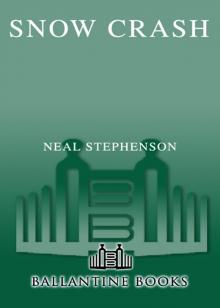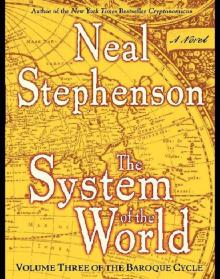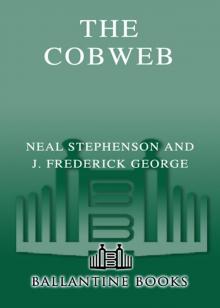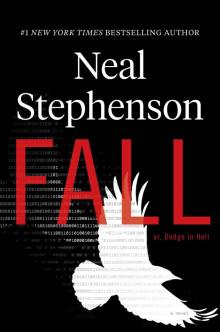- Home
- Neal Stephenson
Termination Shock
Termination Shock Read online
DEDICATION
To A.L.
EPIGRAPH
If it keeps on rainin’, levee’s goin’ to break
If it keeps on rainin’, levee’s goin’ to break
And the water come in, have no place to stay . . .
I works on the levee, mama both night and day
I works on the levee, mama both night and day
I works so hard, to keep the water away
—KANSAS JOE MCCOY AND MEMPHIS MINNIE
CONTENTS
Dedication
Epigraph
Texas
Pentapotamia
Louisiana
The Mississippi Delta
Amritsar
Houston
The Camp on the Brazos
Houston
Chandigarh
West Texas
Himachal Pradesh
The Chihuahuan Desert
Rohtang
South Texas
Nederland
The Line of Actual Control
Pina2bo
Big Fish
The Hague
The Blue Herons
The Marble Mine
The Storm
The Barracks
Eindhoven
The Line of Actual Control
Informateur
Eight Months Later
Cyberabad
The Beaver
Vadan
The Line
Tuaba
Coolattin, British Columbia
Sneeuwberg
Trail
St. Patrick’s
The Columbia River
Uncle Ed’s
Squeegee Ninja
Rijsttafel
Performative War
Flying S
The Pecan Orchard
Pina2bo
Combustion Chamber
Queen of the Netherworld
Acknowledgements
About the Author
Also by Neal Stephenson
Back Ad
Copyright
TEXAS
Houston’s air was too hot to support airplanes. Oh, the queen’s jet could have landed there, given that, during the flight from Schiphol, it had converted ten thousand kilograms of fuel into carbon dioxide and dumped it into the atmosphere. Refueled, though, it could not safely take off until the heat wave broke. And what was going to break it was a hurricane.
Under the direction of air traffic controllers, Frederika Mathilde Louisa Saskia—for that was the queen’s given name—and her co-pilot, a Royal Dutch Air Force captain named Johan, began to drive the jet through a series of maneuvers that would culminate in Waco.
Now, maybe Waco was not the optimal choice for them. But there was no point in quibbling over it. The business jet, slightly crowded with seven souls aboard, flew higher and faster than airliners. It had been slicing through the lower stratosphere at better than six hundred miles per hour, almost ready to begin its descent into Houston, when they had gotten the news about the insufficiency of that city’s air. A decision had to be made. It didn’t have to be the best possible decision.
As she was informed by Texan voices on the radio, as well as Willem coming up to the cockpit with whatever he’d gleaned over the jet’s data link, a thunderstorm had swept over Waco in the last few hours, dropping the temperature to a mere 45. Or 113 as they measured things in the States. Low enough, anyway, that they could at least look it up in the tables of important numbers that the jet’s manufacturer had calculated three decades ago, when this design had been certified. It had never entered those people’s minds that it would get as hot as it was today in Houston, so the tables didn’t go that high.
Waco’s airport would give them everything they really needed. It had two runways arranged in a V. Current winds dictated that they should land on the more westerly of those, southbound. The air traffic controllers told them what to do. They did it.
Those controllers had their hands full juggling a large number of planes—mostly airliners—that had likewise been disappointed in their hopes of landing in Houston. Most of them needed larger airports and so it didn’t seem right to argue with them about whether Waco was perfect. These transmissions could be heard by anyone with a radio. They were being recorded. It was of some importance that they not make waves, not draw attention to themselves. The queen had been raised from infancy never to seem as though she were arrogating royal prerogatives. For to do so would be un-Dutch. It would merely give ammunition to anti-royalists. Lennert, her security chief, was coming around to the view that Waco would be fine. There was a hangar suitable for jets like this one. Willem had already reserved hotel rooms and worked out how to rent cars.
All she had to do was get the jet on the ground. She was good at that. Even if she weren’t, Johan could do it with no help from her.
Along with royalty and wealth, she had inherited from her father this strange pastime of piloting jet airplanes. Despite being a king, he had moonlighted as an airline pilot for KLM—Koninklijke Luchtvaart Maatschappij—Royal Dutch Airlines, whose logo was actually a crown. As Papa had explained to her long ago, there was a reason he had become a pilot. It was that when he was at the controls he had not merely the opportunity but the sacred obligation to focus solely on the machine that was keeping him and his passengers alive.
There were two things about this statement that little Princess Frederika Mathilde Louisa Saskia hadn’t fully understood at the time.
One (more obvious): because Mama and Papa had tried to raise her as some semblance of a normal human being, she hadn’t understood until much later how many demands the crown placed on one’s attention. Now she knew this very well.
Two (which had only come to her recently): “the machine that was keeping him and his passengers alive” was a metaphor for the Netherlands: an engineered contraption that would kill a lot of Dutch people if they didn’t keep pushing the right buttons.
She felt a sense of freedom and clarity of mind while at the controls of an airplane during the descent and the preparations for landing. It was all a matter of operating the controls so as to keep certain numbers within certain ranges. By the time the jet was skimming the runway at Waco, its speed needed to have been reduced to a figure denoted VREF. This varied with such conditions as temperature, weight of the aircraft, and runway conditions; but anyway it could be calculated from those thirty-year-old tables and there were known procedures for getting the plane’s speed down to that number.
At the same time they needed to pass vertically downward through the entire troposphere—the shell of air surrounding the earth, where weather happened—until the number on the altimeter matched whatever the altitude of Waco was. Again there were known procedures for achieving that, all of which needed to mesh with the series of turns dictated by those harried Texan air traffic controllers. The operation of the jet’s controls toward the systematic achievement of those objectives, the terse, pithy, but utterly calm exchanges with Johan and with the voices on the radio, all combined to put her into a state of being that the Dutch referred to as normal with the accent on the second syllable. A different thing altogether from the English “NORMal.”
To explain “norMAL” fully would fill a book, but the most important thing about it, if you happened to be a member of the Dutch royal family, was that “norMAL” was exactly what royals were forever under suspicion of not being, and so anything you could do that made you norMAL was desirable; and since that could easily be faked, it worked best if it were some activity that would get you killed if you did it wrong.
If you rode your bicycle to school, as she had famously done when she had been a little girl, haters could and would claim it was a publicity stunt and scoff at anyone naive enough to fall for it. But even the most frothing anti-royalists could not deny that the king or queen had actually landed that plane, and that, had they just been faking it, they’d have ended up dead. Moreover, it was not something a monkey could do. Even a royal could not get certified for it until she had taken in a fair bit of mathematics, physics, engineering, and meteorology. In the distant past, kings had shown the world that they meant it by strapping on a sword and riding into war, putting their lives on the line. Getting behind the controls of a plane and pointing it at a runway was as close as one could reasonably come in the modern world to the same public blood oath.
Her staff were thinking of details she wouldn’t have—and ought not to, given her present responsibilities. It was a natural mistake to think of Waco as cool, simply because it wasn’t as hot as Houston. But in truth the plane would become an oven the moment it touched down. Getting out of it wouldn’t much improve matters; inside or outside, it was only a matter of time before they all succumbed to heatstroke. So a plan needed to be in place to get the plane and its occupants at least under shade and preferably into air-conditioning within minutes of touching down. They had earthsuits in the cargo hold, of course, charged and ready to go, but the idea of breaking them out this early felt panicky and amateurish.
She just had to land the thing, and there was no particular reason why this should be difficult. The hurricane menacing Houston was hundreds of kilometers away over the Gulf. Air was choppy in the wake of that earlier thunderstorm, but nothing she hadn’t flown through many times in Dutch skies. It was broad daylight, about four in the afternoon. The spiraling oblong descent dictated by the air traffic controllers gave her a good look at the greater Waco area. It was flat and green. Not as flat as home. But this was a landscape that as fa
r as the eye could see was uncomplicated by anything resembling a hill. The green was darker than the Netherlands’ pastures and croplands—lots of forest and scrub.
Slowly her view zoomed in. They got lined up on the runway, which was still too distant to be clearly visible. Beyond the airport was the city itself, only a few buildings and towers raising their heads above what looked to be a well-tended canopy of shade trees. It had a lot of parks. The city’s outskirts faded to a grayer shade—newer developments, perhaps, with less mature trees? Just to the right of their projected course was a big lake, buffered from the open greensward of the airport by a nubby carpet of vegetation so dark green it was almost black. She could tell from the lake’s shape that it was artificial. Dutchwoman that she was, she couldn’t help tracing its shoreline until she identified the long straight section that had to be the dam. It was a low earthen structure pierced by a spillway, not far beyond the end of the runway.
These impressions were all gathered in an almost subliminal way over the ten or so minutes it took to bring the jet down. During that time there was surprisingly little to do. She and Johan had trimmed the plane so that its weight exceeded the lift produced by its wings; in accordance with the laws of physics, this caused it to lose altitude in a steady and predictable manner. Airspeed slowly declined through two hundred knots, headed toward VREF, which today was 137 knots. Soon they would deploy the flaps. Her eyes glanced in a circuit among several key indicators. It was an old jet. Many of the controls were mechanical switches set in black Bakelite panels with embossed white letters, very old school. But the important stuff in the middle was “all glass” in pilot-speak: glorious jewel-colored screens with virtual instruments, retrofitted into the old dashboard. Her eyes knew where to find the really important data—airspeed, altitude, roll, pitch, yaw.
But looking out the windscreen at the real world was important too. A small single-engine plane landed far ahead of them and taxied out of their way. The land flashed unpredictably here and there. They saw this all the time at home. There was local flooding. Not enough to submerge vast areas but enough to strew patches of standing water, glazing the flat landscape where drainage was slow and soil saturated. When one of those puddles caught the sun, light skidded into her eye. The airport, though, seemed to be well drained—the tower would have warned them of puddles on the runways. The runway was easy to see now, dead ahead, right where it ought to be, splotched with damp but not wet. Final approach took them low over a subdivision. Most of the airport spread away to their left. To the right of the runway was just a narrow strip of grass running between the tarmac and a security fence. Immediately outside of and parallel to the fence was a two-lane road. This bordered dark forested land that extended for a kilometer or two to the lake’s convoluted shore. The woods were speckled in some places with little eruptions of dark red earth and in others with blue rectangles—tarps pitched over makeshift camps.
Always fascinating to her was this slow inexorable zooming in. Twenty minutes ago she’d have found it difficult to pick out the greater Waco metropolitan area below the black-blue vault of the stratosphere, but now as they dropped through a hundred meters of altitude she could see, in the backyards of houses, blue swimming pools—a lighter tint of blue than that of the tarps in the woods. Children—presumably much better off than the ones under the tarps—were cooling off after school by jumping into them. Her thoughts strayed momentarily to her own daughter, but she put Lotte out of her mind for now and instead checked the instruments for the hundredth time. Movement to the right of the runway created a moment of anxiety until she saw it was just a pickup truck driving down the cracked and water-splotched two-laner outside the airport’s perimeter fence. Its brake lights came on for some reason. No concern of hers.
They cleared the fence at the near end of the runway. Any anxiety she might have felt in the last seconds of the flight as to whether speed, altitude, angle of attack were correct was dispelled by the fact that Johan was perfectly relaxed. They were as one. It was just a matter of waiting for the moment, any second now, when the tires would touch the tarmac and the jet would become a really expensive and unwieldy car. The high placement of the windscreen, combined with the jet’s slightly nose-up attitude, made it impossible to see the runway directly ahead of them. But this jet was fitted with a video camera in its belly, enabling them to see what was below on a small screen set into the panel between the pilot’s and co-pilot’s chairs. Normally she ignored it while landing, since it never showed anything except clean unobstructed pavement. But she was hearing shocked exclamations from people back in the cabin, on the right side of the plane, who had apparently just witnessed something incredible. Incredible and not good. She liked to leave the cockpit door open so that curious passengers could gaze up the aisle and see out the front; but now it sounded like they were seeing something she couldn’t.
She was just beginning to wonder if they might need to abort the landing when unusual movement caught her eye on the belly camera screen.
She glanced at it just long enough to see a sort of dark churning mass of four-legged creatures directly below the plane, moving from right to left across their path.
The jet jerked powerfully rightward. The right landing gear, under the wing, had struck something that wasn’t supposed to be there. They had not touched down yet and so the tires had no purchase on the ground. The nose swung hard to the right while plunging downward, smashing the front landing gear into the pavement at an awkward angle—not before it slammed into additional obstacles on the runway.
They were traveling at VREF, which as Texans measured such things was about 160 miles per hour. Pavement came up toward her. The jet was moving at least as much sideways as forward—skittering so violently that her eyes could not focus on the instruments. The belly cam screen had gone largely red, the camera’s lens spattered with either blood or hydraulic fluid. Where it wasn’t red it was blurred, hurtling green. No, it was the color of the sky. No, green again. She was flung forward against her safety harness. The interior of the plane was a thumping cacophony of flying luggage. Some bit of the jet—a wingtip?—must have dug into the sodden ground. There was nothing for it now but to shed those hundred and sixty miles per hour by damaging the landscape.
Pigs. It had taken her mind a few moments to identify the four-legged animals that had made a momentary appearance in the belly cam as they had boiled across the runway. They were pigs. More like wild boars than domestic farm animals. This was a now totally useless fact supplied by her brain as they tumbled and skidded diagonally across the grass and entered into a complicated relationship with the chain-link fence.
And then blessedly the jet had stopped. Hot air spread across her face; the hull of the plane had been breached. It smelled like jet fuel. This gave her a powerful incentive to unbuckle her safety harness. Gravity then caused her to end up on top of Johan, who was slower to move. Blood was running down his face and dripping from his ear. It originated from a laceration clearly visible through his reddish-blond eyebrow. That eye was closed, but the other was open and tracking, albeit drunkenly. His arms and legs were moving. Almost certainly a concussion. She undid his safety harness.
Getting out of the cockpit was diabolically hard because gravity was the wrong way. She had to think like a rock climber and find hand- and footholds. A strong hand grabbed her wrist and pulled her out of a tight spot. Lennert satisfying himself that his queen was alive. That accomplished, he turned his attention to the door, which was basically above them. Gravity again was not his friend, but braced on one side by his queen and on the other by his deputy Amelia, Lennert was able to reach the lever that was supposed to open it. She was worried that it would be too damaged to work. But the doorway, which almost cut the plane in half structurally, had to be ridiculously strong and stiff. Lennert was able to operate the lever and get the door moving with one good foot stomp. It fell open to reveal a partly cloudy blue sky. He got both hands on the door frame and pulled-pushed himself up and out, then squatted on the fuselage next to the aperture for a look around. The sun was on his face, which was suddenly wet. The human body couldn’t sweat that fast—this was moisture from the air condensing on his relatively cool skin.

 Zodiac: The Eco-Thriller
Zodiac: The Eco-Thriller The Mongoliad: Book One
The Mongoliad: Book One Snow Crash
Snow Crash The Confusion: Volume Two of the Baroque Cycle
The Confusion: Volume Two of the Baroque Cycle The Rise and Fall of D.O.D.O.
The Rise and Fall of D.O.D.O. The Diamond Age: Or, a Young Lady's Illustrated Primer
The Diamond Age: Or, a Young Lady's Illustrated Primer The Big U
The Big U The System of the World: Volume Three of the Baroque Cycle
The System of the World: Volume Three of the Baroque Cycle The Cobweb
The Cobweb Reamde
Reamde Fall; or, Dodge in Hell
Fall; or, Dodge in Hell Interface
Interface Quicksilver
Quicksilver The Mongoliad: Book Three
The Mongoliad: Book Three Seveneves
Seveneves Atmosphæra Incognita
Atmosphæra Incognita In the Beginning...Was the Command Line
In the Beginning...Was the Command Line Anathem
Anathem The Rise and Fall of D.O.D.O.: A Novel
The Rise and Fall of D.O.D.O.: A Novel The Mongoliad: Book Two
The Mongoliad: Book Two Diamond Age or a Young Lady's Illustrated Primer
Diamond Age or a Young Lady's Illustrated Primer THE System OF THE WORLD
THE System OF THE WORLD The Mongoliad: Book One tfs-1
The Mongoliad: Book One tfs-1 Some Remarks: Essays and Other Writing
Some Remarks: Essays and Other Writing Zodiac
Zodiac Spew
Spew The Baroque Cycle: Quicksilver, the Confusion, and the System of the World
The Baroque Cycle: Quicksilver, the Confusion, and the System of the World The Diamond Age
The Diamond Age Reamde: A Novel
Reamde: A Novel In the Kingdom of Mao Bell
In the Kingdom of Mao Bell Mother Earth Mother Board
Mother Earth Mother Board Twelve Tomorrows - Visionary stories of the near future inspired by today's technologies
Twelve Tomorrows - Visionary stories of the near future inspired by today's technologies The Confusion
The Confusion The Great Simoleon Caper
The Great Simoleon Caper The Mongoliad: Book Three tfs-3
The Mongoliad: Book Three tfs-3